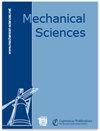Design and analysis of a hollow-ring permanent magnet brake for robot joints
IF 1.5
4区 工程技术
Q4 ENGINEERING, MECHANICAL
引用次数: 0
Abstract
Abstract. An electromagnetic brake is the key basic component to ensure the safety of robot joints. The conventional electromagnetic brake mostly uses a set of springs to provide braking force and solenoid power to provide a recovery force, which makes this kind of brake with large thickness and small braking torque that is not conducive to the application in light and small joint components. In many design processes, unclear understanding of the machine-electric-magnetic coupling characteristics leads to relatively simple theoretical models and inaccurate theoretical results, which do not provide more help for subsequent designs. In this paper, a hollow-ring type permanent magnetic power-loss protection brake, integrated inside a joint assembly, is designed. The brake uses rare earth Nd–Fe–B permanent magnets to provide braking suction instead of ordinary spring packs, and achieves motion guidance and braking torque transmission by means of leaf spring. Combined with the deformation model of the leaf spring and the magnetic circuit models of the brake under the power-on and power-off conditions, the overall coupling dynamics model of the brake is established. The theoretical results are compared through finite-element software, and a prototype is produced for experimental testing. Finally, the accuracy and validity of the theoretical model are verified, providing a theoretical and experimental basis for the design of this type of brake.机器人关节用空心环永磁制动器的设计与分析
摘要电磁制动器是保证机器人关节安全的关键基础部件。传统的电磁制动器大多采用一组弹簧提供制动力,电磁电源提供恢复力,这使得这种制动器厚度大,制动力矩小,不利于在轻、小关节部件上的应用。在许多设计过程中,由于对机-电-磁耦合特性认识不清,导致理论模型相对简单,理论结果不准确,不能为后续设计提供更多帮助。本文设计了一种集成在接头组件内的空心环型永磁失电保护制动器。制动器采用稀土Nd-Fe-B永磁体代替普通弹簧包提供制动吸力,并通过板簧实现运动引导和制动力矩传递。结合板簧在上下电工况下的变形模型和制动器磁路模型,建立制动器整体耦合动力学模型。通过有限元软件对理论结果进行了比较,并制作了样机进行了实验测试。最后,验证了理论模型的准确性和有效性,为该类制动器的设计提供了理论和实验依据。
本文章由计算机程序翻译,如有差异,请以英文原文为准。
求助全文
约1分钟内获得全文
求助全文
来源期刊

Mechanical Sciences
ENGINEERING, MECHANICAL-
CiteScore
2.20
自引率
7.10%
发文量
74
审稿时长
29 weeks
期刊介绍:
The journal Mechanical Sciences (MS) is an international forum for the dissemination of original contributions in the field of theoretical and applied mechanics. Its main ambition is to provide a platform for young researchers to build up a portfolio of high-quality peer-reviewed journal articles. To this end we employ an open-access publication model with moderate page charges, aiming for fast publication and great citation opportunities. A large board of reputable editors makes this possible. The journal will also publish special issues dealing with the current state of the art and future research directions in mechanical sciences. While in-depth research articles are preferred, review articles and short communications will also be considered. We intend and believe to provide a means of publication which complements established journals in the field.
 求助内容:
求助内容: 应助结果提醒方式:
应助结果提醒方式:


